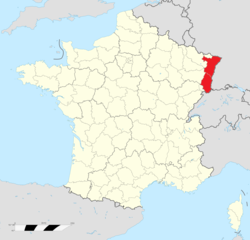The European Collectivity of Alsace (French: Collectivité européenne d'Alsace; Alsatian: D'Europäischa Gebiatskärwerschàft Elsàss; German: Europäische Gebietskörperschaft Elsass[5]) is a territorial collectivity in the Alsace region of France. On 1 January 2021, the departments of Bas-Rhin and Haut-Rhin merged to form a territorial collectivity, but remained part of the Grand Est region. The creation of this new entity was approved by the French Parliament on 25 July 2019 and Law 2019-816, which delimits its powers, was promulgated on 2 August 2019.[2]
European Collectivity of Alsace Collectivité européenne d'Alsace (French) | |
|---|---|
 | |
| Status | Collectivity of the French Republic |
| Capital and largest city | Strasbourg 48°35′N 7°45′E / 48.583°N 7.750°E |
| Official language | French |
| Regional languages | Alsatian Welche Meridional Frankish Rhine Frankish |
| Demonym(s) | Alsatian |
| Government | |
• President of the Assembly | Frédéric Bierry[1] |
| Legislature | Assembly of Alsace |
| Establishment | |
• Creation | 1 January 2021[2] |
| Area | |
• Total | 8,280 km2 (3,200 sq mi) |
| Population | |
• 2021 census | 1,919,745[3][4] |
| ISO 3166 code | FR-6AE |
Alsatian voters had already voted in favour of the creation of a single territorial collectivity in a referendum in 2013; however, in the less populous of the two departments, Haut-Rhin, a majority of voters had rejected the proposal.[6]
History
editThe original Region of Alsace, created in 1956, ceased to exist on 1 January 2016, when the French parliament voted to merge several administrative regions, reducing their number from 22 to 18.[7]
Status
editAlsace has an intermediary status: its competencies are those of a department, plus some of the competencies of a region. As a result, Alsace is less autonomous than Corsica or the overseas departments and regions.
Languages
editWhile French is the sole official language of the country according to Article 2 of the Constitution of France, Law 2019-816 contains provisions to promote regional languages in schools. The collectivity will also be tasked with creating a Committee related to the Alsatian language and culture, with a focus on the German language spoken in Alsace. This last provision is closely related to Chapter 3 and Chapter 4 of the Aachen Treaty.
Tranport in Alsace
editThe A35 motorway runs through Alsace from south to north, covering approximately 180 km. This non-toll motorway was transferred from the state to the European Collectivity of Alsace on January 1, 2021, except for the section passing through the Strasbourg Eurometropolis. Alsace is also served by two major east-west axes: the A4 motorway (Paris - Strasbourg), operated by Sanef, and the A36 motorway (Beaune - Mulhouse), operated by APRR.
Alsace was one of the pioneering regions in railway development, with Nicolas Koechlin beginning the construction of the first railway lines as early as 1839. Today, the rail network offers dense coverage of the region. The Strasbourg to Basel line, known as the "Plain of Alsace Line," is serviced by regional trains (TER) running at speeds of up to 200 km/h. This line, along with the Alsatian portion of the Paris-Strasbourg line, forms part of an important transport corridor connecting Switzerland, Luxembourg, and Belgium. Alsace is also strategically positioned at the intersection of two high-speed rail lines, thanks to the LGV Est européenne and the LGV Rhin-Rhône. The European Collectivity of Alsace could play a role in reopening cross-border rail lines between Haguenau and Rastatt, and between Colmar and Vieux-Brisach.
The Rhine River is Europe's primary navigable waterway. The Central Commission for the Navigation of the Rhine has been headquartered in Strasbourg since 1920. The ports of Strasbourg and Mulhouse are the second and third largest river ports in France.
Finally, Alsace is home to two airports: the Basel-Mulhouse airport, the only bi-national airport in the world, and Strasbourg-Entzheim airport.
References
edit- ^ "Résultat de l'élection du président de la Collectivité européenne d'Alsace". www.alsace.eu (in French). 2021-01-02. Archived from the original on 2021-01-02. Retrieved 2022-06-27.
- ^ a b Government of the French Republic (2 August 2019). "LOI n° 2019-816 du 2 août 2019 relative aux compétences de la Collectivité européenne d'Alsace". legifrance.gouv.fr (in French). Retrieved 15 January 2020.
- ^ Combined 2021 population of the departements of Bas-Rhin and Haut-Rhin.
- ^ "Populations légales des départements en 2021". INSEE. Retrieved 16 January 2024.
- ^ "Aus zwei mach eins". Eurojournalist(e) (in German). 2019-06-26. Retrieved 2020-10-26.
- ^ "Echec du référendum alsacien : "Un signe fort pour la classe politique en place"". Le Monde (in French). 7 April 2013. Retrieved 15 January 2020.
- ^ "Le 1er janvier, la France passe à 13 régions en métropole". Le Point (in French). 30 December 2015. Retrieved 15 January 2020.
External links
edit- European Collectivity of Alsace Archived 2021-06-02 at the Wayback Machine

